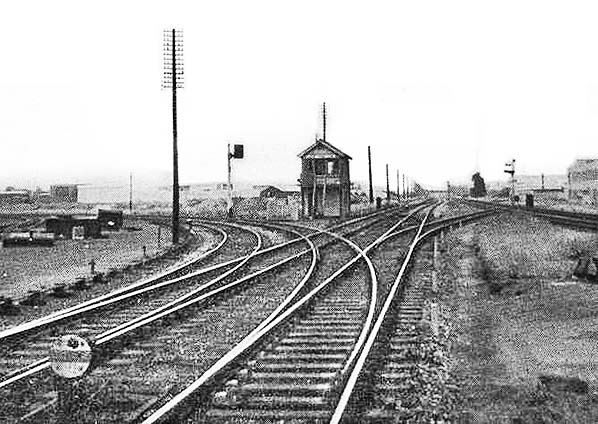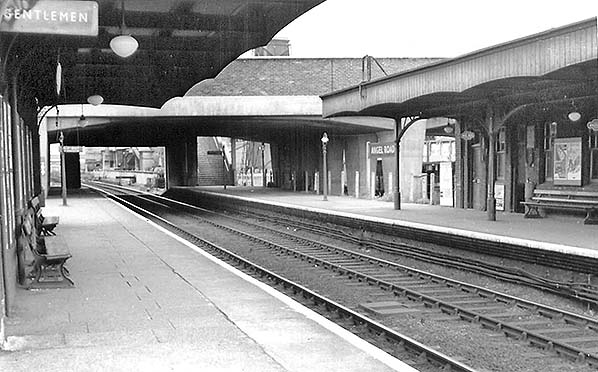
road_old7.jpg) Looking north from the up platform at Angel Road station from an elevated position, perhaps the steps down from the booking office. The date is a little later than the previous picture (mid - late 1959s), the lamp on the left no longer has a tablet but totem signs have not yet been fitted. The goods loops are visible on the right behind the up platform. In the distance the Enfield line is seen curving to the left alongside the Angel Road Junction signal box. Oil and coal wagons are seen in the goods yard, one siding with loaded coal wagons runs immediately behind the down platform.
Photo from John Mann collection road_old4.jpg)
Angel Road station looking north from the down platform in October 1958. The structures on top of the canopies are a mystery, there are seen in several photos. Totem signs have now been fitted to the lamps and beneath the canopies. They look like some kind of lamp bracket and may have been out of use by this time,
Photo
from John Mann collection
 Angel Road Junction with the McKenzie and Holland signal box with a 45 lever frame in 1959. The box survived until 9.3.1969. The Enfield Town line is seen curving to the left with the goods loops which ran behind the up platform to the right.
Photo from John Mann collection old11.jpg) Sometime in the early 1960s a Derby Suburban DMU of the type which became Class 125 has just left Angel Road, right background, on a Broxbourne - Liverpool Street service assuming the headcode is correctly set. The train is passing the gasworks of what was originally the Tottenham & Edmonton Gas Light and Coke Co., dating from 1847. The works was usually referred to as Tottenham Gasworks and less commonly Angel Road Gasworks. The original gas company was eventually renamed to Tottenham & District Gas Company and in 1949 came under the jurisdiction of the nationalised Eastern Gas Board. The Tottenham & District company ceased to legally exist in 1959, a date which is sometimes incorrectly taken as meaning the year the gasworks ceased operation; this did not occur until 1972 or thereabouts. Rail access to the gasworks was possible via connections as seen here on the left, behind the brakevan, or from a connection via Angel Road goods yard; this was in effect a loop passing Angel Road station on its west side. The brakevan is of LMS origin and was a variant of a Midland Railway design. The coal train to which is was attached is not destined for the gasworks. The wagon tippler at the gasworks was designed for wagons with end, as opposed to side, doors which latter is evident here. The Class 125s of which there were 20 3-car units was constructed in 1958 - 1959 and entered service during the latter year. They were designed for the Lea Valley Line services which were not fully electrified until 1969, the original scheme of 1960 being via Seven Sisters (the Southbury Loop). Class 125 operated virtually all local services operating via Angel Road. Extension of electrification in 1969 saw the class transferred to King's Cross suburban services. As for Tottenham gasworks, the site stood largely derelict for many years and at the time of writing was finally being cleared for development. The new (2019) Meridian Water station sits more or less at the location seen in the photograph. Click here for a more detailed caption.
Photo from John Turner's Flickr Photostream road_old13.jpg) In January 1962, Class J15 0-6-0 No.65476 stands on the track between Angel Road's goods shed and the station's Down platform. The train is most likely from the gasworks to the south of the station, which was served via a number of connections from the track seen here. Shunting within the gasworks was performed by the internal locomotive fleet of what by this time was the Eastern Gas Board. The track between goods shed and station was in effect a lengthy loop, connecting at its north end to the Lower Edmonton branch which was still open for goods traffic at the time of the photograph. The letters 'CO' are assumed to mean 'Coal Only', suggesting gasworks traffic, but it must be stressed this assumption remained unconfirmed at the time of writing. The LNER/BR Class J15 began life in 1883 as GER Class Y14 to a design by T. W. Worsdell. BR No.65476 was new ex-works during James Holden's tenure in August 1913 as GER No.551 and entered service the following month. When new, she would have had a stovepipe chimney and a lower cab roof; the latter was originally of wood, covered with canvas and lead paint. She is here seen paired with a tender-cab to facilitate tender-first running. At the formation of the LNER in 1923, 272 were still in service of which 126 went on to serve British Railways. No.65476 was destined to become one of the final four in service, all being withdrawn on 16 September 1962.
Click here for a more detailed caption. Photo by Bob Todd 
Angel Road station looking south from the up platform c.mid 1960s. Angel Road (North Circular Road) straddles the south end of the station. The station entrance has been relocated to the south side of the North Circular, this was done to accommodate the widening and realignment of the North Circular which was completed in 1975. A goods siding runs behind the down platform, under the North Circular and into the gas works on the south side of the road. The gas works closed in 1972 but are still largely intact.
Photo from John Mann collection road_old9.jpg)
Angel Road station looking south from the down platform c.mid 1960s, the entrance building now on the south side of the viaduct is seen. This is the original building, when the road was relagined the building was reversed
Photo from John Mann collection old12.jpg)
Angel Road down platform in 1966. The down platform building was substantially longer than that on the up side. The closure date for the goods yard is not know but it is clearly still open at this date. The track has been relaid with flat-bottomed rail and concrete sleepers. The junction with the Edmonton branch and its signalling is still in situ. By that date a short section towards Montagu Road was still been in use for access to the goods yard from the north end.
Photo
by JE Connor
road1.jpg)
Angel Road station looking north at the down platform from a passing train in July.1976. The line was electrified in May 1969. The platform buildings have been demolished and replaced by two bus shelter. Station lighting has also been replaced as has the station signage. The blue BR Eastern Region signs have gone and have been replaced by black on white corporate identity signs fixed to the lamp posts. No closure date for the good yard has been found but it was almost certainly closed by this date although the goods shed is still standing.
Photo by Alan Young road2.jpg) By May 1981 station lighting had been replaced again but despite this and what appears to be new seats the station looks bleak and run down. This view is looking south towards Angel Road. This view is taken after the North Circular Road has been widened and realigned to the north. At this time the street level building on Angel Road was demolished and a new entrance building constructed on the south side of the new viaduct. Steps down to the platform from this building can just be made out
under the bridge. Photo by Alan Young road10.jpg)
Angel Road station entrance on the south side of the North Circular Road viaduct in July 1987. When the North Circular was realigned to the north the original street level entrance building was retained. The building had been on the north side of the old alignment but was on the south side of the new alignment. The entrance into the booking office was from what has been the rear of the building. That building was later replaced by the building seen here. Steps down to the down platform can be seen on the left, they go under the bridge. Facilities at Angel Road were basic, passengers arriving at the station by road could pull up in the lay-by.
Photo by John Attfield road11.jpg) Angel Road station looking south of the down platform in July 1987. Two enclosed bus shelters were provided for protection from the weather. Angel Road station looking south of the down platform in July 1987. Two enclosed bus shelters were provided for protection from the weather.Photo by John Attfield Click here for Angel Road Station Gallery 3:
|


 Home Page
Home Page